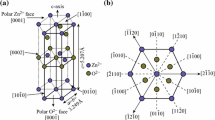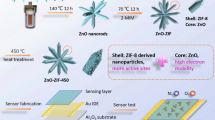Abstract
The high concentration of nitrogen dioxide (NO2) gets it one of the most popular and harmful air pollutants. This work examines the NO2 gas sensing properties of palladium-doped zinc oxide (Pd-ZnO) nanorods. The Pd-ZnO nanorods were synthesized by chemical hydrothermal method with different Pd doping concentrations (0–1 wt%). The Pd-ZnO nanorods were characterized by XRD, FESEM, and XPS for their structural and morphological properties, respectively. The ZnO nanostructures show hexagonal structures, and XRD and XPS results confirmed the doping of Pd on ZnO nanostructures. The Pd (1 wt%)-ZnO nanorods-based sensor shows high response of 22.1 with response/recovery time of 67/118 s toward 100 ppm NO2, while it exhibits a response of 7 with response/recovery times of 80/145 s for 1 ppm NO2, at 200 °C. The sensor is observed very selective for NO2 compared to other gases like carbon monoxide (CO), ammonia (NH3), and hydrogen (H2). The sensor has strong stability for a longer time (35 days) in a dry and humid (RH 60%) environment. The mechanism of gas sensors is further explained by the Crowell-Sze model in Finite-Difference Time-Domain (FDTD) simulation using COMSOL Multiphysics using drift Diffusion-Poisson equations to simulate the electric potential distribution in the nanorods during the gas sensing.











Similar content being viewed by others
Data availability
The data that support the findings of this study are available from the corresponding author, upon reasonable request.
References
S. Tyagi, M. Chaudhary, A.K. Ambedkar, K. Sharma, Y.K. Gautam, B.P. Singh, Metal oxide nanomaterial-based sensors for monitoring environmental NO2 and its impact on the plant ecosystem: a review. Sens. Diagn. 1, 106–129 (2022)
A. Sanger, S.B. Kang, M.H. Jeong, M.J. Im, I.Y. Choi, C.U. Kim et al., Morphology-controlled aluminum-doped zinc oxide nanofibers for highly sensitive NO2 sensors with full recovery at room temperature. Adv. Sci. 5, 1800816 (2018)
J. Jaiswal, A. Sanger, P. Tiwari, R. Chandra, MoS2 hybrid heterostructure thin film decorated with CdTe quantum dots for room temperature NO2 gas sensor. Sens. Actuators, B Chem. 305, 127437 (2020)
A. Sanger, P.K. Jain, Y.K. Mishra, R. Chandra, Palladium decorated silicon carbide nanocauliflowers for hydrogen gas sensing application. Sens. Actuators, B Chem. 242, 694–699 (2017)
A. Sanger, A. Kumar, S. Chauhan, Y.K. Gautam, R. Chandra, Fast and reversible hydrogen sensing properties of Pd/Mg thin film modified by hydrophobic porous silicon substrate. Sens. Actuators, B Chem. 213, 252–260 (2015)
A. Sanger, A. Kumar, A. Kumar, J. Jaiswal, R. Chandra, A fast response/recovery of hydrophobic Pd/V2O5 thin films for hydrogen gas sensing. Sens. Actuators, B Chem. 236, 16–26 (2016)
M. Arif, A. Sanger, A. Singh, Highly sensitive NiO nanoparticle based chlorine gas sensor. J. Electron. Mater. 47, 3451–3458 (2018)
A. Sanger, S.B. Kang, M.H. Jeong, C.U. Kim, J.M. Baik, K.J. Choi, All-transparent NO2 gas sensors based on freestanding Al-doped ZnO nanofibers. ACS Appl. Electron. Mater. 1, 1261–1268 (2019)
R.D. Woodson, Chapter 8—OSHA regulations, in Construction hazardous materials compliance guide. ed. by R.D. Woodson (Butterworth-Heinemann, Boston, 2012), pp.115–143
T. Zhou, T. Zhang, Recent progress of nanostructured sensing materials from 0D to 3D: overview of structure–property-application relationship for gas sensors. Small Methods 5, 2100515 (2021)
C. Wang, L. Yin, L. Zhang, D. Xiang, R. Gao, Metal oxide gas sensors: sensitivity and influencing factors. Sensors 10, 2088–2106 (2010)
J. Xuan, G. Zhao, M. Sun, F. Jia, X. Wang, T. Zhou et al., Low-temperature operating ZnO-based NO2 sensors: a review. RSC Adv. 10, 39786–39807 (2020)
Y. Kang, F. Yu, L. Zhang, W. Wang, L. Chen, Y. Li, Review of ZnO-based nanomaterials in gas sensors. Solid State Ionics 360, 115544 (2021)
M.A. Franco, P.P. Conti, R.S. Andre, D.S. Correa, A review on chemiresistive ZnO gas sensors. Sens. Actuators Rep. 4, 100100 (2022)
A. Sanger, A. Kumar, A. Kumar, R. Chandra, Highly sensitive and selective hydrogen gas sensor using sputtered grown Pd decorated MnO2 nanowalls. Sens. Actuators, B Chem. 234, 8–14 (2016)
A. Yu, Z. Li, J. Yi, Selective detection of parts-per-billion H2S with Pt-decorated ZnO nanorods. Sens. Actuators, B Chem. 333, 129545 (2021)
P. Rai, Y.-S. Kim, H.-M. Song, M.-K. Song, Y.-T. Yu, The role of gold catalyst on the sensing behavior of ZnO nanorods for CO and NO2 gases. Sens. Actuators, B Chem. 165, 133–142 (2012)
Y.-H. Liu, S.-J. Chang, L.-T. Lai, Y.-P. Tu, S.-J. Young, Aluminum-doped zinc oxide nanorods and methyl alcohol gas sensor application. Microsyst. Technol. 28, 377–382 (2022)
N.F. Idris, N.A. Mohd Yahya, M.H. Yaacob, A.H. Idris, S.W. Harun, N. Saidin, Optical fiber coated zinc oxide (ZnO) nanorods decorated with palladium (Pd) for hydrogen sensing. Opt. Mater. 96, 109291 (2019)
M. Kamal Hossain, Q. Ahmed Drmosh, Noble Metal-decorated nanostructured zinc oxide: strategies to advance chemiresistive hydrogen gas sensing. Chem. Rec. 22, e202200090 (2022)
P. Yadav, A. Kumar, A. Sanger, Y.K. Gautam, B.P. Singh, Sputter-Grown Pd-capped CuO thin films for a highly sensitive and selective hydrogen gas sensor. J. Electron. Mater. 50, 192–200 (2021)
D.T. Thu, H.T. Hien, D.T.A. Thu, P.Q. Ngan, G.H. Thai, C.V. Tuan et al., Schottky contacts of (Au, Pt)/nanotube-titanates for fast response to NO2 gas at room temperature. Sens. Actuators, B Chem. 244, 941–948 (2017)
C.R. Crowell, S.M. Sze, Current transport in metal-semiconductor barriers. Solid-State Electron. 9, 1035–1048 (1966)
M. Hessien, E. Da’na, K. Al-Amer, M.M. Khalaf, Nano ZnO (hexagonal wurtzite) of different shapes under various conditions: fabrication and characterization. Mater. Res. Express 6, 085057 (2019)
U. Holzwarth, N. Gibson, The Scherrer equation versus the ‘Debye–Scherrer equation.’ Nat. Nanotechnol. 6, 534 (2011)
A.K. Ambedkar, M. Singh, V. Kumar, V. Kumar, B.P. Singh, A. Kumar et al., Structural, optical and thermoelectric properties of Al-doped ZnO thin films prepared by spray pyrolysis. Surf. Interfaces 19, 100504 (2020)
P. Gunawan, L. Mei, J. Teo, J. Ma, J. Highfield, Q. Li et al., Ultrahigh sensitivity of Au/1D α-Fe2O3 to acetone and the sensing mechanism. Langmuir 28, 14090–14099 (2012)
J. Sun, L. Sun, N. Han, J. Pan, W. Liu, S. Bai et al., Ordered mesoporous WO3/ZnO nanocomposites with isotype heterojunctions for sensitive detection of NO2. Sens. Actuators, B Chem. 285, 68–75 (2019)
M.W. Ahn, K.S. Park, J.H. Heo, D.W. Kim, K.J. Choi, J.G. Park, On-chip fabrication of ZnO-nanowire gas sensor with high gas sensitivity. Sens. Actuators, B Chem. 138, 168–173 (2009)
N. Tamaekong, C. Liewhiran, A. Wisitsoraat, A. Tuantranont, S. Phanichphant, NO2 sensing properties of flame-made MnOx-loaded ZnO-nanoparticle thick film. Sens. Actuators, B Chem. 204, 239–249 (2014)
S.K. Shaikh, V.V. Ganbavle, S.I. Inamdar, K.Y. Rajpure, Multifunctional zinc oxide thin films for high-performance UV photodetectors and nitrogen dioxide gas sensors. RSC Adv. 6, 25641–25650 (2016)
L. Chandra, P.K. Sahu, R. Dwivedi, V.N. Mishra, Electrical and NO2 sensing characteristics of Pd/ZnO nanoparticles based Schottky diode at room temperature. Mater. Res. Express 4, 125017 (2017)
T.V.A. Kusumam, V.S. Siril, K.N. Madhusoodanan, M. Prashantkumar, Y.T. Ravikiran, N.K. Renuka, NO2 gas sensing performance of zinc oxide nanostructures synthesized by surfactant assisted Low temperature hydrothermal technique. Sens. Actuators, A 318, 112389 (2021)
J.X. Wang, X.W. Sun, Y. Yang, C.M. Wu, N-P transition sensing behaviors of ZnO nanotubes exposed to NO2 gas. Nanotechnology 20, 465501 (2009)
S. Tyagi, A. Kumar, A. Kumar, Y.K. Gautam, V. Kumar, Y. Kumar et al., Enhancement in the sensitivity and selectivity of Cu functionalized MoS2 nanoworm thin films for nitrogen dioxide gas sensor. Mater. Res. Bull. 150, 111784 (2022)
S.-W. Choi, S.-H. Jung, S.S. Kim, Functionalization of selectively grown networked SnO2 nanowires with Pd nanodots by γ-ray radiolysis. Nanotechnology 22, 225501 (2011)
C.-M. Chang, M.-H. Hon, I.-C. Leu, Improvement in CO sensing characteristics by decorating ZnO nanorod arrays with Pd nanoparticles and the related mechanisms. RSC Adv. 2, 2469–2475 (2012)
C.J. Lee, T.J. Lee, S.C. Lyu, Y. Zhang, H. Ruh, H.J. Lee, Field emission from well-aligned zinc oxide nanowires grown at low temperature. Appl. Phys. Lett. 81, 3648–3650 (2002)
H. Lee, M. Shin, M. Lee, Y.J. Hwang, Photo-oxidation activities on Pd-doped TiO2 nanoparticles: critical PdO formation effect. Appl. Catal. B 165, 20–26 (2015)
J. Rogal, K. Reuter, M. Scheffler, Thermodynamic stability of PdO surfaces. Phys. Rev. B 69, 075421 (2004)
A.A. Zhukova, M.N. Rumyantseva, V.B. Zaytsev, A.V. Zaytseva, A.M. Abakumov, A.M. Gaskov, Pd nanoparticles on SnO2(Sb) whiskers: aggregation and reactivity in CO detection. J. Alloy. Compd. 565, 6–10 (2013)
A. Oprea, D. Degler, N. Barsan, A. Hemeryck, J. Rebholz, 3—Basics of semiconducting metal oxide–based gas sensors, in Gas sensors based on conducting metal oxides. ed. by N. Barsan, K. Schierbaum (Elsevier, Amsterdam, 2019), pp.61–165
S. Roso, F. Güell, P.R. Martínez-Alanis, A. Urakawa, E. Llobet, Synthesis of ZnO nanowires and impacts of their orientation and defects on their gas sensing properties. Sens. Actuators, B Chem. 230, 109–114 (2016)
P. Rai, S. Raj, K.-J. Ko, K.-K. Park, Y.-T. Yu, Synthesis of flower-like ZnO microstructures for gas sensor applications. Sens. Actuators, B Chem. 178, 107–112 (2013)
C. Jin, S. Park, H. Kim, C. Lee, Ultrasensitive multiple networked Ga2O3-core/ZnO-shell nanorod gas sensors. Sens. Actuators, B Chem. 161, 223–228 (2012)
V.V. Ganbavle, S.I. Inamdar, G.L. Agawane, J.H. Kim, K.Y. Rajpure, Synthesis of fast response, highly sensitive and selective Ni:ZnO based NO2 sensor. Chem. Eng. J. 286, 36–47 (2016)
V.L. Patil, S.A. Vanalakar, P.S. Patil, J.H. Kim, Fabrication of nanostructured ZnO thin films based NO2 gas sensor via SILAR technique. Sens. Actuators, B Chem. 239, 1185–1193 (2017)
C. Xiao, T. Yang, M. Chuai, B. Xiao, M. Zhang, Synthesis of ZnO nanosheet arrays with exposed (100) facets for gas sensing applications. Phys. Chem. Chem. Phys. 18, 325–330 (2016)
C.W. Zou, J. Wang, W. Xie, Synthesis and enhanced NO2 gas sensing properties of ZnO nanorods/TiO2 nanoparticles heterojunction composites. J. Colloid Interface Sci. 478, 22–28 (2016)
H.W. Kim, Y.J. Kwon, A. Mirzaei, S.Y. Kang, M.S. Choi, J.H. Bang et al., Synthesis of zinc oxide semiconductors-graphene nanocomposites by microwave irradiation for application to gas sensors. Sens. Actuators, B Chem. 249, 590–601 (2017)
C. Zou, F. Liang, S. Xue, Synthesis and oxygen vacancy related NO2 gas sensing properties of ZnO: Co nanorods arrays gown by a hydrothermal method. Appl. Surf. Sci. 353, 1061–1069 (2015)
Acknowledgements
The authors would like to thank to Prof. Ramesh Chandra, IIC, IIT Roorkee, and India for providing FESEM & XRD facilities. The authors would like to thank CCS University Meerut [(DEV/URGS/2022-23/39)] for supporting this research work. Author Mr. Durvesh Gautam also thank to CSIR-SRF (1620/CSIR NET June 2019) New Delhi, India. Dr. Ashwani Kumar extends sincere appreciation to CSIR-SRA (Pool Scientist), New Delhi, for their generous financial support (Grant No. 13(9131)-A/2020-Pool), which facilitated the completion of this research endeavor.
Funding
The authors have not disclosed any funding.
Author information
Authors and Affiliations
Contributions
AKA contributed toward investigation, and writing-original draft; DKG contributed toward methodology, and writing-review & editing; MS contributed toward writing-review & editing and resources; SV contributed toward conceptualization and methodology; BPS contributed toward investigation, and writing-review & editing; AKM contributed toward data curation, and software; SBK contributed toward software and formal analysis; AK contributed toward writing-original draft and supervision; AS contributed toward writing-review & editing and supervision; and YKG contributed toward resources, investigation, and supervision.
Corresponding authors
Ethics declarations
Conflict of interest
The authors declare that there are no conflict of interest regarding the research work reported in this manuscript.
Additional information
Publisher's Note
Springer Nature remains neutral with regard to jurisdictional claims in published maps and institutional affiliations.
Supplementary Information
Below is the link to the electronic supplementary material.
Rights and permissions
Springer Nature or its licensor (e.g. a society or other partner) holds exclusive rights to this article under a publishing agreement with the author(s) or other rightsholder(s); author self-archiving of the accepted manuscript version of this article is solely governed by the terms of such publishing agreement and applicable law.
About this article
Cite this article
Ambedkar, A.K., Gautam, D., Singh, M. et al. Experimental and theoretical investigation of palladium-doped zinc oxide nanorods for NO2 gas sensor. J Mater Sci: Mater Electron 34, 2213 (2023). https://doi.org/10.1007/s10854-023-11657-3
Received:
Accepted:
Published:
DOI: https://doi.org/10.1007/s10854-023-11657-3




